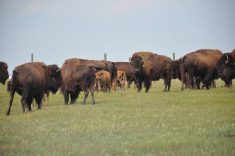REGINA — The Wilson crew may have had one of the coldest spots in the Agribition barn, but the Bashaw, Alta., ranchers have also had one of their hottest show seasons ever.
Lee and Dawn Wilson maintained a hot pace this year as their 2011 show season wound up at Canadian Western Agribition. They marketed purebred Angus genetics, judged cattle, groomed and won major awards throughout the year.
Their performance at Farmfair in Edmonton was one of the highlights of their career since they met at Agribition more than two decades ago. The Edmonton show awarded them supreme bull and female championships and presented them with two new Dodge trucks.
Read Also

Trump’s tariffs take their toll on U.S. producers
U.S. farmers say Trump’s tariffs have been devastating for growers in that country.
“When you can drive home a truck, that is amazing. When you drive home two trucks, that is the thrill of a lifetime,” Dawn said.
The cattle provide the glue that keeps the central Alberta family of five together.
Their three adult children are fully involved in the farm but also have their own diverse interests.
Dakota is a clothing designer, Ty is a massage therapist and musician who recently released his first CD and Jaelayne has finished high school and has an interest in photography and fashion. The ranch always pulls them back.
“I don’t know what we would do without them,” said their mother.
The Wilsons judge shows as a couple or alone. Last spring Dawn judged the national Angus show in Sydney, Australia, and Lee handled the national Angus show in Mexico.
They have done considerable export business with the Mexicans, but Lee was concerned about what he saw there as the country continues to suffer under a serious drought.
“The top end would be competitive here, but for the people in the northern part, their cattle are skinny and they absolutely cannot buy feed,” he said.
Quality is important to the Wilsons.
Many major livestock shows including Agribition have seen entries fall off as the national herd shrinks and people retire, but the caliber of cattle remains strong.
“I think the top end is so much stronger than it used to be,” said Lee.
“We have lost a lot of mediocre type cattle. It is way more competitive. Our numbers may be down a little bit, but the quality is up.”
As long-time judges of large shows, the Wilsons have seen a new pattern emerge where selecting an obvious winner is more challenging.
“You’ll see a class now and you’ll love every one of them. In years gone by, that wasn’t necessarily the case,” Dawn said.
These shows are an investment and expensive to attend, but they have paid off for the Wilsons because of the international exposure.
Their cattle can be found in 27 countries with most exported as semen and embryos.
A greater payoff is friendship and close family.
They have made multiple generations of friends and have watched everyone’s children grow up at these events.
“It is a phenomenal fraternity,” Dawn said.
While they took a year off from the show ring to help customers fit and present their own cattle, they returned to the winners’ circle this year and still feel competitive with no desire to retire.
“We’ll know when it’s time. We enjoy the people, we enjoy the conversations,” she said. “We have made some very dear friends over the years.”
At the end of the day, they are ranchers who contend with the same challenges as their neighbours. Their ranch in central Alberta has suffered through grasshoppers, two years of drought and closed borders after BSE was discovered in Canada in 2003.
“The drought and BSE was a double whammy,” Lee said. “The drought was probably as bad as BSE.”
They sell most of their bulls privately, including to commercial customers who are more optimistic this year because of better prices.
“People work hard for every dollar they can get and if they can earn a few extra dollars, that is pretty darn nice,” Dawn said.
They also want feedback from their bull customers on carcass information.
“We have a couple bull customers with five or six years of kill data and I need to analyze it,” Lee said.
Top grades have been achieved, and they want to take the time to further assess the data and see which sire lines are earning the premiums when the cattle go through the feedlot.
DNA testing is a new technology they have not yet used.
“Our focus is more on really studying the actual cattle, studying their dam, their sire and their phenotype, looking at the numbers,” Dawn said.
“There is tons of technology people can use and that is great.”
Lee would like to expand, but the limiting factor is land prices that have doubled in their area from $1,100 to $2,500 per acre in recent years.
“Our land base will only accommodate so many cows,” Lee said. “If we had more land, we would have more cows.”















